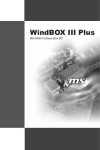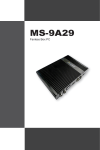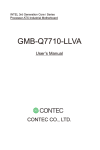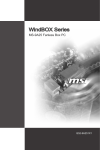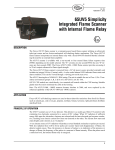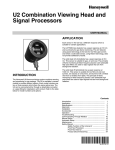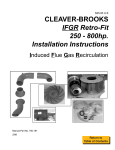Download MSI WindBOX Series User`s manual
Transcript
WindBOX series MS-9A45 Fanless Box PC ▍ Preface Copyright Notice The material in this document is the intellectual property of MICRO-STAR INTERNATIONAL. We take every care in the preparation of this document, but no guarantee is given as to the correctness of its contents. Our products are under continual improvement and we reserve the right to make changes without notice. Trademarks All trademarks are the properties of their respective owners. ■ ■ ■ ■ ■ ■ ■ MSI® is a registered trademark of Micro-Star Int’l Co.,Ltd. NVIDIA® is a registered trademark of NVIDIA Corporation. ATI® and AMD® are registered trademarks of AMD Corporation. Intel® is a registered trademark of Intel Corporation. Windows® is a registered trademark of Microsoft Corporation. AMI® is a registered trademark of Advanced Micro Devices, Inc. Award® is a registered trademark of Phoenix Technologies Ltd. Revision Revision Date V1.0 2012/04 Technical Support If a problem arises with your system and no solution can be obtained from the user’s manual, please contact your place of purchase or local distributor. Alternatively, please try the following help resources for further guidance. ■ ■ Visit the MSI website for technical guide, BIOS updates, driver updates, and other information: http://www.msi.com/service/download/ Contact our technical staff at: http://support.msi.com/ ii MS-9A45 Chemical Substances Information In compliance with chemical substances regulations, such as the EU REACH Regulation (Regulation EC No. 1907/2006 of the European Parliament and the Council), MSI provides the information of chemical substances in products at: http://www.msi.com/html/popup/csr/evmtprtt_pcm.html Battery Information European Union: Batteries, battery packs, and accumulators should not be disposed of as unsorted household waste. Please use the public collection system to return, recycle, or treat them in compliance with the local regulations. Taiwan: For better environmental protection, waste batteries should be collected separately for recycling or special disposal. California, USA: The button cell battery may contain perchlorate material and requires special handling when recycled or disposed of in California. For further information please visit: http://www.dtsc.ca.gov/hazardouswaste/perchlorate/ Danger of explosion if battery is incorrectly replaced. Replace only with the same or equivalent type recommended by the manufacturer. iii ▍ Preface Safety Instructions ■ ■ ■ ■ ■ ■ ■ ■ ■ ■ ■ ■ Always read the safety instructions carefully. Keep this User’s Manual for future reference. Keep this equipment away from humidity. Lay this equipment on a reliable flat surface before setting it up. The openings on the enclosure are for air convection hence protects the equipment from overheating. DO NOT COVER THE OPENINGS. Make sure the voltage of the power source and adjust properly 110/220V before connecting the equipment to the power inlet. Place the power cord such a way that people can not step on it. Do not place anything over the power cord. Always Unplug the Power Cord before inserting any add-on card or module. All cautions and warnings on the equipment should be noted. Never pour any liquid into the opening that could damage or cause electrical shock. If any of the following situations arises, get the equipment checked by service personnel: ◯ ◯ ◯ ◯ The power cord or plug is damaged. ◯ ◯ The equipment has dropped and damaged. Liquid has penetrated into the equipment. The equipment has been exposed to moisture. The equipment does not work well or you can not get it work according to User’s Manual. The equipment has obvious sign of breakage. DO NOT LEAVE THIS EQUIPMENT IN AN ENVIRONMENT UNCONDITIONED, STORAGE TEMPERATURE ABOVE 60oC (140oF), IT MAY DAMAGE THE EQUIPMENT. 警告使用者: 這是甲類資訊產品,在居住的環境中使用時,可能會造成無線電干擾,在這 種情況下,使用者會被要求採取某些適當的對策。 iv MS-9A45 CE Conformity Hereby, Micro-Star International CO., LTD declares that this device is in compliance with the essential safety requirements and other relevant provisions set out in the European Directive. FCC-B Radio Frequency Interference Statement This equipment has been tested and found to comply with the limits for a Class B digital device, pursuant to Part 15 of the FCC Rules. These limits are designed to provide reasonable protection against harmful interference in a residential installation. This equipment generates, uses and can radiate radio frequency energy and, if not installed and used in accordance with the instruction manual, may cause harmful interference to radio communications. However, there is no guarantee that interference will not occur in a particular installation. If this equipment does cause harmful interference to radio or television reception, which can be determined by turning the equipment off and on, the user is encouraged to try to correct the interference by one or more of the measures listed below: ■ ■ ■ ■ Reorient or relocate the receiving antenna. Increase the separation between the equipment and receiver. Connect the equipment into an outlet on a circuit different from that to which the receiver is connected. Consult the dealer or an experienced radio/television technician for help. Notice 1 The changes or modifications not expressly approved by the party responsible for compliance could void the user’s authority to operate the equipment. Notice 2 Shielded interface cables and AC power cord, if any, must be used in order to comply with the emission limits. VOIR LA NOTICE D’INSTALLATION AVANT DE RACCORDER AU RESEAU. This device complies with Part 15 of the FCC Rules. Operation is subject to the following two conditions: 1. this device may not cause harmful interference, and 2. this device must accept any interference received, including interference that may cause undesired operation. ▍ Preface WEEE Statement ENGLISH Under the European Union (“EU”) Directive on Waste Electrical and Electronic Equipment, Directive 2002/96/EC, which takes effect on August 13, 2005, products of “electrical and electronic equipment” cannot be discarded as municipal waste anymore and manufacturers of covered electronic equipment will be obligated to take back such products at the end of their useful life. DEUTSCH Gemäß der Richtlinie 2002/96/EG über Elektro- und Elektronik-Altgeräte dürfen Elektround Elektronik-Altgeräte nicht mehr als kommunale Abfälle entsorgt werden. Wir haben europaweit verschiedene Sammel- und Recyclingunternehmen beauftragt, die in die Europäische Union in Verkehr gebrachten Produkte, am Ende seines Lebenszyklus zurückzunehmen. Bitte entsorgen Sie dieses Produkt zum gegebenen Zeitpunkt ausschliesslich an einer lokalen Altgerätesammelstelle in Ihrer Nähe. FRANÇAIS Au sujet de la directive européenne (EU) relative aux déchets des équipement électriques et électroniques, directive 2002/96/EC, prenant effet le 13 août 2005, que les produits électriques et électroniques ne peuvent être déposés dans les décharges ou tout simplement mis à la poubelle. Les fabricants de ces équipements seront obligés de récupérer certains produits en fin de vie. Par conséquent vous pouvez retourner localement ces matériels dans les points de collecte. РУССКИЙ В соответствии с директивой Европейского Союза (ЕС) по предотвращению загрязнения окружающей среды использованным электрическим и электронным оборудованием (директива WEEE 2002/96/EC), вступающей в силу 13 августа 2005 года, изделия, относящиеся к электрическому и электронному оборудованию, не могут рассматриваться как бытовой мусор, поэтому производители вышеперечисленного электронного оборудования обязаны принимать его для переработки по окончании срока службы. ESPAÑOL Bajo la directiva 2002/96/EC de la Unión Europea en materia de desechos y/o equipos electrónicos, con fecha de rigor desde el 13 de agosto de 2005, los productos clasificados como “eléctricos y equipos electrónicos” no pueden ser depositados en los contenedores habituales de su municipio, los fabricantes de equipos electrónicos, están obligados a hacerse cargo de dichos productos al termino de su período de vida. vi MS-9A45 NEDERLANDS De richtlijn van de Europese Unie (EU) met betrekking tot Vervuiling van Electrische en Electronische producten (2002/96/EC), die op 13 Augustus 2005 in zal gaan kunnen niet meer beschouwd worden als vervuiling. Fabrikanten van dit soort producten worden verplicht om producten retour te nemen aan het eind van hun levenscyclus. SRPSKI Po Direktivi Evropske unije (“EU”) o odbačenoj ekektronskoj i električnoj opremi, Direktiva 2002/96/EC, koja stupa na snagu od 13. Avgusta 2005, proizvodi koji spadaju pod “elektronsku i električnu opremu” ne mogu više biti odbačeni kao običan otpad i proizvođači ove opreme biće prinuđeni da uzmu natrag ove proizvode na kraju njihovog uobičajenog veka trajanja. POLSKI Zgodnie z Dyrektywą Unii Europejskiej (“UE”) dotyczącą odpadów produktów elektrycznych i elektronicznych (Dyrektywa 2002/96/EC), która wchodzi w życie 13 sierpnia 2005, tzw. “produkty oraz wyposażenie elektryczne i elektroniczne “ nie mogą być traktowane jako śmieci komunalne, tak więc producenci tych produktów będą zobowiązani do odbierania ich w momencie gdy produkt jest wycofywany z użycia. TÜRKÇE Avrupa Birliği (AB) Kararnamesi Elektrik ve Elektronik Malzeme Atığı, 2002/96/EC Kararnamesi altında 13 Ağustos 2005 tarihinden itibaren geçerli olmak üzere, elektrikli ve elektronik malzemeler diğer atıklar gibi çöpe atılamayacak ve bu elektonik cihazların üreticileri, cihazların kullanım süreleri bittikten sonra ürünleri geri toplamakla yükümlü olacaktır. ČESKY Podle směrnice Evropské unie (“EU”) o likvidaci elektrických a elektronických výrobků 2002/96/EC platné od 13. srpna 2005 je zakázáno likvidovat “elektrické a elektronické výrobky” v běžném komunálním odpadu a výrobci elektronických výrobků, na které se tato směrnice vztahuje, budou povinni odebírat takové výrobky zpět po skončení jejich životnosti. MAGYAR Az Európai Unió („EU”) 2005. augusztus 13-án hatályba lépő, az elektromos és elektronikus berendezések hulladékairól szóló 2002/96/EK irányelve szerint az elektromos és elektronikus berendezések többé nem kezelhetőek lakossági hulladékként, és az ilyen elektronikus berendezések gyártói kötelessé válnak az ilyen termékek visszavételére azok hasznos élettartama végén. ITALIANO In base alla Direttiva dell’Unione Europea (EU) sullo Smaltimento dei Materiali Elettrici ed Elettronici, Direttiva 2002/96/EC in vigore dal 13 Agosto 2005, prodotti appartenenti alla categoria dei Materiali Elettrici ed Elettronici non possono più essere eliminati come rifiuti municipali: i produttori di detti materiali saranno obbligati a ritirare ogni prodotto alla fine del suo ciclo di vita. vii ▍ Preface Contents Copyright Notice������������������������������������������������������������������������������������ ii Trademarks�������������������������������������������������������������������������������������������� ii Revision������������������������������������������������������������������������������������������������� ii Technical Support��������������������������������������������������������������������������������� ii Chemical Substances Information����������������������������������������������������� iii Battery Information������������������������������������������������������������������������������ iii Safety Instructions������������������������������������������������������������������������������� iv CE Conformity��������������������������������������������������������������������������������������� v FCC-B Radio Frequency Interference Statement������������������������������� v WEEE Statement���������������������������������������������������������������������������������� vi Chapter 1 Overview���������������������������������������������������������������������������� 1-1 Packing Contents������������������������������������������������������������������������� 1-2 System Overview������������������������������������������������������������������������� 1-3 System Specifications������������������������������������������������������������������ 1-6 Chapter 2 System Setup�������������������������������������������������������������������� 2-1 Installation Tools�������������������������������������������������������������������������� 2-2 System Setup������������������������������������������������������������������������������� 2-3 Chapter 3 BIOS Setup������������������������������������������������������������������������ 3-1 Entering Setup����������������������������������������������������������������������������� 3-2 The Menu Bar������������������������������������������������������������������������������ 3-4 Main��������������������������������������������������������������������������������������������� 3-5 Advanced������������������������������������������������������������������������������������� 3-6 Boot�������������������������������������������������������������������������������������������� 3-12 Security�������������������������������������������������������������������������������������� 3-13 Chipset��������������������������������������������������������������������������������������� 3-14 Power����������������������������������������������������������������������������������������� 3-15 Save & Exit�������������������������������������������������������������������������������� 3-17 viii Chapter 1 Overview Thank you for choosing the WindBOX, an excellent industrial computer system from MSI. The WindBOX eliminates the noise and the risk of fan’s failure by adopting wide heatsink as fanless solution. It also supports VESA wall-mount interface for various scenarios like digital signage, thin client, and POS with affordable expenditure, which not only meets the demand of Industrial applications but also fulfills the needs of companies, governments, and institutes for general applications. ▍ Overview Packing Contents Power Adapter MS-9A45 System Power Cord VESA Mount Plate User’s Manual Wireless LAN Antenna Driver/Utility Disk ■ Please contact us immediately if any of the item is damaged or missing. ■ The picture is for your reference only and your packing contents may slightly vary depending on the model you purchased. 1-2 MS-9A45 System Overview Side View-1 4 1 2 3 1 Gigabit LAN Jack 2 Headphone Jack (Green) 3 Microphone Jack (Pink) 4 USB Port 5 6 The standard RJ-45 LAN jack is for connection to the Local Area Network (LAN). You can connect a network cable to it. This connector is provided for headphones or speakers. This connector is provided for microphones. The USB (Universal Serial Bus) port is for attaching USB devices such as keyboard, mouse, or other USB-compatible devices. 1-3 ▍ Overview 1-4 5 DVI-I Port 6 Antenna Connector The DVI-I (Digital Visual Interface-Integrated) connector allows you to connect an LCD monitor. It provides a high-speed digital interconnection between the computer and its display device. To connect an LCD monitor, simply plug your monitor cable into the DVI connector, and make sure that the other end of the cable is properly connected to your monitor (refer to your monitor manual for more information.) This connector allows you to connect an external antenna for wireless LAN. MS-9A45 Side View-2 1 2 3 4 1 Antenna Connector (Optional) 2 USB Ports 3 HDMI-Out Port 5 6 This connector allows you to connect an external antenna for wireless LAN. The USB (Universal Serial Bus) port is for attaching USB devices such as keyboard, mouse, or other USB-compatible devices. The High-Definition Multimedia Interface (HDMI) is an all-digital audio/video interface capable of transmitting uncompressed streams. HDMI supports all TV format, including standard, enhanced, or high-definition video, plus multichannel digital audio on a single cable. 4 Power Button 5 Serial Port 6 Power Jack Press this button to turn the system on or off. The serial port is a 16550A high speed communications port that sends/ receives 16 bytes FIFOs. You can attach a serial mouse or other serial devices directly to the connector. The power adapter converts AC power to DC power for this jack. Power supplied through this jack supplies power to the system. To prevent damage to the system, always use the supplied power adapter. 1-5 ▍ Overview System Specifications 1-6 CPU ■ Intel Cedarview-D processor Chipset ■ North Bridge: integrated with CPU ■ South Bridge: Intel NM10 chipset Memory ■ 1 DDR3 1066MHz Non-ECC SO-DIMM slot ■ Supports the maximum of 4GB LAN ■ 2 Intel 82574L GbE controllers Storage ■ 2 SATA 3Gb/s ports by Intel NM10 chipset Audio ■ HDA Codec by Realtek® ALC887 ■ Compliant with Azalia 1.0 specs Graphics ■ Intel 3600 series integrated Graphics Engine ■ Resolution up to 1920 x 1200 pixels Left Panel Input/Output ■ ■ ■ ■ ■ ■ 1 wireless LAN antenna connector (optional) 2 USB 2.0 ports 1 HDMI-Out port 1 power button 1 RS-232/422/485 serial port 1 DC power jack Right Panel Input/Output ■ ■ ■ ■ ■ ■ 2 Gigabit LAN jacks 1 headphone/speaker jack (green) 1 microphone jack (pink) 1 USB 2.0 port 1 DVI-I port 1 wireless LAN antenna connector Power Supply ■ 40 watt power adapter with active PFC ■ Input: 100-240V~, 50-60Hz, 1.7A ■ Output: 20V 2.0A Dimension & Weight ■ 260 mm (W) X 180 mm (D) X 19 mm (H) ■ 1.08 Kg MS-9A45 Regulatory Compliance ■ FCC Class B, CE, C-Tick, BSMI, VCCI, RoHS compliance Environmental ■ Operating Temperature: 0oC to 60oC ■ Storage Temperature: -20oC to 80oC ■ Humidity: 0% ~ 90% RH, non-condensing 1-7 Chapter 2 System Setup This chapter provides you with the information on hardware setup procedures. While doing the installation, be careful in holding the components and follow the installation procedures. For some components, if you install in the wrong orientation, the components will not work properly. Use a grounded wrist strap before handling computer components. Static electricity may damage the components. Important • Always unplug the power cord before installing any components. • When the operating temperature reaches 40oC or higher, please replace your HDD with SSD (SolidState Drive) or other types of heat-resistant HDD to protect your HDD from being damaged by high temperature. ▍ System Setup Installation Tools A Phillips (crosshead) screwdriver and a flathead screwdriver, can be used to do most of the installation. Choose one with a magnetic head would be better. Pliers, can be used as an auxiliary tool to connect some connectors or cables. Forceps, can be used to pick up tiny screws or set up the jumpers. Rubber gloves, can prevent yourself from being incised and suffering the static charge. 2-2 MS-9A45 System Setup Step 1: Locate the VESA mount screw holes on the back of the LCD monitor. Step 2: Fasten the VESA mount plate to the monitor with the supplied screws. 2-3 ▍ System Setup Step 3: Mount the system onto the VESA mount plate. Step 4: Tighten the thumbscrew at the bottom of the VESA mount plate to secure the system. 2-4 MS-9A45 Step 5: Locate the wireless LAN antenna connector and install the antenna. Step 6: Locate the signal cable of the monitor and connect one end of the cable to the DVI port of the system. You may need to get an adapter if the supplied signal cable isn’t DVI-interfaced. Step 7: Connect the other end of the signal cable to the monitor. Connect the monitor power cord to the monitor and to the power source. 2-5 ▍ System Setup Step 8: Assemble the system power adapter and the power cord. Connect the power adapter to the system and then connect the power cord to the power source. Important We suggest that you connect the power adapter to your system first and then connect the power cord to the socket-outlet for safety concerns. Step 9: Turn on the system and enjoy it. 2-6 Chapter 3 BIOS Setup This chapter provides information on the BIOS Setup program and allows you to configure the system for optimum use. You may need to run the Setup program when: ■ An error message appears on the screen during the system booting up, and requests you to run SETUP. ■ You want to change the default settings for customized features. ▍ BIOS Setup Entering Setup Power on the computer and the system will start POST (Power On Self Test) process. When the message below appears on the screen, press <DEL> key to enter Setup. Press DEL to enter SETUP If the message disappears before you respond and you still wish to enter Setup, restart the system by turning it OFF and On or pressing the RESET button. You may also restart the system by simultaneously pressing <Ctrl>, <Alt>, and <Delete> keys. Important The items under each BIOS category described in this chapter are under continuous update for better system performance. Therefore, the description may be slightly different from the latest BIOS and should be held for reference only. 3-2 MS-9A45 Control Keys ←→ Select Screen ↑↓ Select Item Enter Select +- Change Option F1 General Help F7 Previous Values F9 Optimized Defaults F10 Save & Exit Esc Exit Getting Help After entering the Setup menu, the first menu you will see is the Main Menu. Main Menu The main menu lists the setup functions you can make changes to. You can use the arrow keys ( ↑↓ ) to select the item. The on-line description of the highlighted setup function is displayed at the bottom of the screen. Sub-Menu If you find a right pointer symbol appears to the left of certain fields that means a sub-menu can be launched from this field. A sub-menu contains additional options for a field parameter. You can use arrow keys ( ↑↓ ) to highlight the field and press <Enter> to call up the sub-menu. Then you can use the control keys to enter values and move from field to field within a sub-menu. If you want to return to the main menu, just press the <Esc >. General Help <F1> The BIOS setup program provides a General Help screen. You can call up this screen from any menu by simply pressing <F1>. The Help screen lists the appropriate keys to use and the possible selections for the highlighted item. Press <Esc> to exit the Help screen. 3-3 ▍ BIOS Setup The Menu Bar ▶ Main Use this menu for basic system configurations, such as time, date, etc. ▶ Advanced Use this menu to set up the items of special enhanced features. ▶ Boot Use this menu to specify the priority of boot devices. ▶ Security Use this menu to set supervisor and user passwords. ▶ Chipset This menu controls the advanced features of the onboard chipsets. ▶ Power Use this menu to specify your settings for power management. ▶ Save & Exit This menu allows you to load the BIOS default values or factory default settings into the BIOS and exit the BIOS setup utility with or without changes. 3-4 MS-9A45 Main ▶ System Date This setting allows you to set the system date. The date format is <Day>, <Month> <Date> <Year>. ▶ System Time This setting allows you to set the system time. The time format is <Hour> <Minute> <Second>. ▶ SATA Mode Selection This setting specifies the SATA controller mode. 3-5 ▍ BIOS Setup Advanced ▶ Quiet Boot This BIOS feature determines if the BIOS should hide the normal POST messages with the motherboard or system manufacturer’s full-screen logo. When it is enabled, the BIOS will display the full-screen logo during the boot-up sequence, hiding normal POST messages. When it is disabled, the BIOS will display the normal POST messages, instead of the full-screen logo. Please note that enabling this BIOS feature often adds 2-3 seconds of delay to the booting sequence. This delay ensures that the logo is displayed for a sufficient amount of time. Therefore, it is recommended that you disable this BIOS feature for a faster boot-up time. ▶ Bootup NumLock State This setting is to set the Num Lock status when the system is powered on. Setting to [On] will turn on the Num Lock key when the system is powered on. Setting to [Off] will allow users to use the arrow keys on the numeric keypad. 3-6 MS-9A45 ▶ Option ROM Messages This item is used to determine the display mode when an optional ROM is initialized during POST. When set to [Force BIOS], the display mode used by AMI BIOS is used. Select [Keep Current] if you want to use the display mode of optional ROM. ▶ CPU Configuration ▶ EIST EIST (Enhanced Intel SpeedStep Technology) allows the system to dynamically adjust processor voltage and core frequency, which can result in decreased average power consumption and decreased average heat production. ▶ Hyper-Threading The processor uses Hyper-Threading technology to increase transaction rates and reduces end-user response times. The technology treats the two cores inside the processor as two logical processors that can execute instructions simultaneously. In this way, the system performance is highly improved. If you disable the function, the processor will use only one core to execute the instructions. Please disable this item if your operating system doesn’t support HT Function, or unreliability and instability may occur. ▶ Execute Disable Bit Intel’s Execute Disable Bit functionality can prevent certain classes of malicious “buffer overflow” attacks when combined with a supporting operating system. This functionality allows the processor to classify 3-7 ▍ BIOS Setup areas in memory by where application code can execute and where it cannot. When a malicious worm attempts to insert code in the buffer, the processor disables code execution, preventing damage or worm propagation. ▶ Limit CPUID Maximum The Max CPUID Value Limit BIOS feature allows you to circumvent problems with older operating systems that do not support the Intel Pentium 4 processor with Hyper-Threading Technology. When enabled, the processor will limit the maximum CPUID input value to 03h when queried, even if the processor supports a higher CPUID input value. When disabled, the processor will return the actual maximum CPUID input value of the processor when queried. ▶ Super IO Configuration ▶ Serial Port 1 This setting enables/disables the specified serial port. ▶ Change Settings This setting is used to change the address & IRQ settings of the specified serial port. ▶ Mode Select Select an operation mode for the serial port 1. 3-8 MS-9A45 ▶ Watch Dog Timer You can enable the system watch-dog timer, a hardware timer that generates a reset when the software that it monitors does not respond as expected each time the watch dog polls it. ▶ H/W Monitor These items display the current status of all monitored hardware devices/components such as voltages, temperatures and all fans’ speeds. 3-9 ▍ BIOS Setup ▶ PCI/PCIE Device Configuration ▶ PCI Latency Timer This item controls how long each PCI device can hold the bus before another takes over. When set to higher values, every PCI device can conduct transactions for a longer time and thus improve the effective PCI bandwidth. For better PCI performance, you should set the item to higher values. ▶ USB Support This setting enables/disables support for USB devices. ▶ Legacy USB Support Set to [Enabled] if you need to use any USB 1.1/2.0 device in the operating system that does not support or have any USB 1.1/2.0 driver installed, such as DOS and SCO Unix. ▶ Audio Controller This setting enables/disables the onboard audio controller. ▶ Launch PXE OpROM This setting enables/disables the initialization of the onboard PXE Boot ROM during bootup. Selecting [Disabled] will speed up the boot process. ▶ Mini-PCIe Slot This setting determines the operation mode of the Mini PCI-E slot. 3-10 MS-9A45 ▶ Serial Port Console Redirection ▶ Console Redirection Console Redirection operates in host systems that do not have a monitor and keyboard attached. This setting enables/disables the operation of console redirection. When set to [Enabled], BIOS redirects and sends all contents that should be displayed on the screen to the serial COM port for display on the terminal screen. Besides, all data received from the serial port is interpreted as keystrokes from a local keyboard. 3-11 ▍ BIOS Setup Boot ▶ Boot Option #1 / #2 / #3 This setting allows users to set the sequence of boot devices where BIOS attempts to load the disk operating system. ▶ Hard Drive BBS Priorities This setting allows users to set the priority of the specified devices. First press <Enter> to enter the sub-menu. Then you may use the arrow keys ( ↑ ↓ ) to select the desired device, then press <+>, <-> or <PageUp>, <PageDown> key to move it up/down in the priority list. 3-12 MS-9A45 Security ▶ Administrator Password Administrator Password controls access to the BIOS Setup utility. ▶ User Password User Password controls access to the system at boot and to the BIOS Setup utility. 3-13 ▍ BIOS Setup Chipset ▶ IGFX - Boot Type Use the field to select the type of device you want to use as the boot display of the system. ▶ Fixed Graphics Memory Size This setting specifies the size of system memory allocated for video memory. 3-14 MS-9A45 Power ▶ ACPI Sleep State This setting specifies the power saving modes for ACPI function. If your operating system supports ACPI, you can choose to enter the Standby mode in S1 (POS) or S3 (STR) fashion through the setting of this field. ▶ Restore AC Power Loss This setting specifies whether your system will reboot after a power failure or interrupt occurs. Available settings are: [Power Off] Leaves the computer in the power off state. [Power On] Leaves the computer in the power on state. [Last State] Restores the system to the previous status before power failure or interrupt occurred. 3-15 ▍ BIOS Setup ▶ Deep S5 The setting enables/disables the Deep S5 power saving mode. S5 is almost the same as G3 Mechanical Off, except that the PSU still supplies power, at a minimum, to the power button to allow return to S0. A full reboot is required. No previous content is retained. Other components may remain powered so the computer can “wake” on input from the keyboard, clock, modem, LAN, or USB device. ▶ Resume On USB from S3/S4 The item allows the activity of the USB device to wake up the system from S3/S4 sleep state. ▶ Resume On PCIE/PCI PME This field specifies whether the system will be awakened from power saving modes when activity or input signal of onboard PCIE/PCI PME is detected. ▶ Resume On RTC When [Enabled], your can set the date and time at which the RTC (real-time clock) alarm awakens the system from suspend mode. 3-16 MS-9A45 Save & Exit ▶ Save Changes and Exit Save changes to CMOS and exit the Setup Utility. ▶ Discard Changes and Exit Abandon all changes and exit the Setup Utility. ▶ Restore Defaults Restore the factory defaults. ▶ Save as User Defaults Save all changes as user defaults. ▶ Restore User Defaults Restore the preset user defaults. 3-17







































